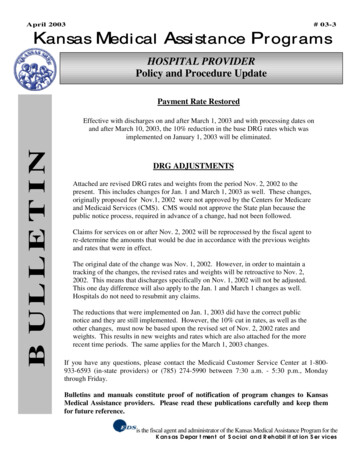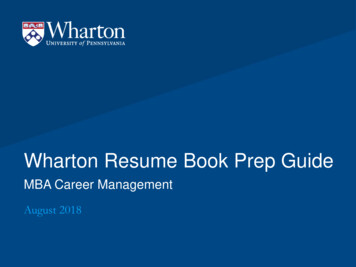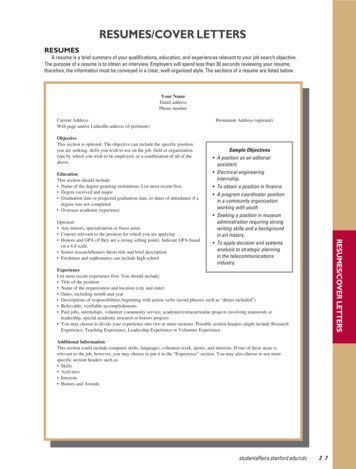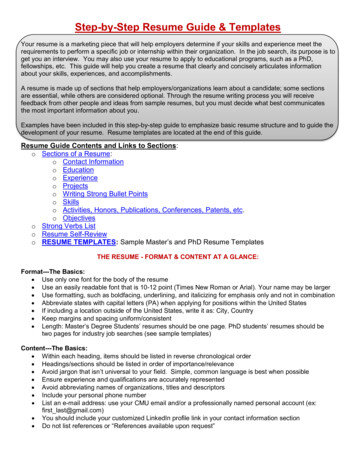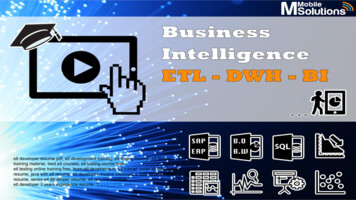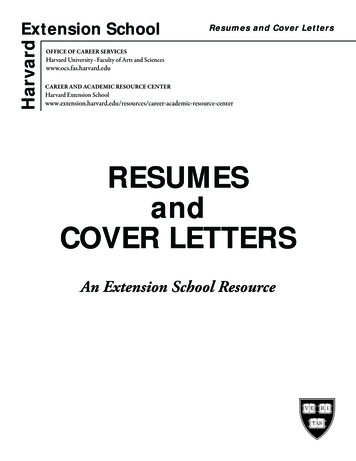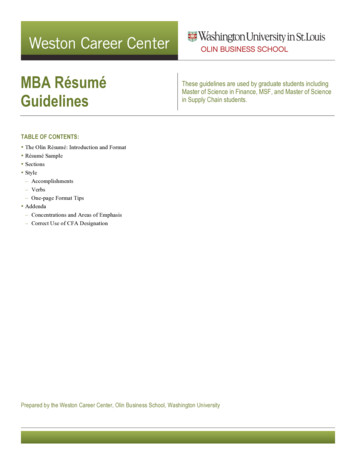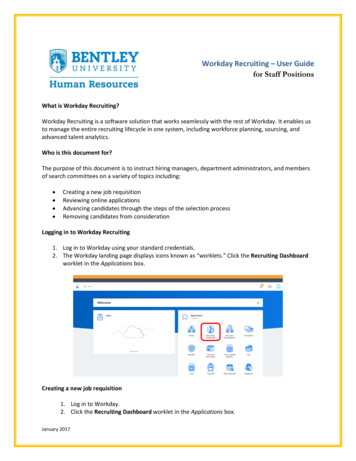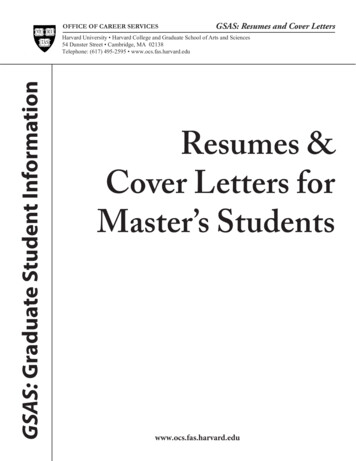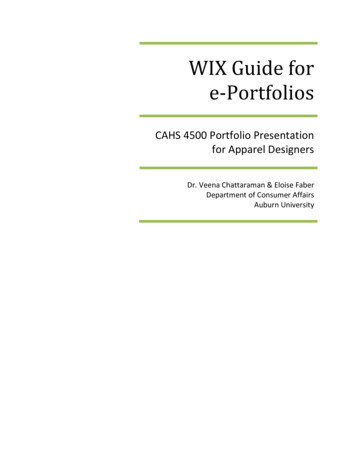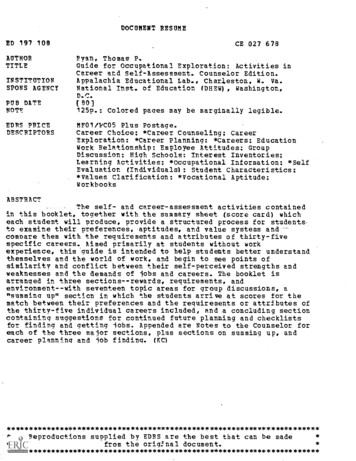
Transcription
DOCUMENT RESUMEED 197 10BCE 027 67BAUTHORTITLERyan, Thomas P.Guide for Occupational Exploration: Activities inCareer and Self-Assessment. Counselor Edition.Appalachia Educational Lab., Charleston, W. Va.National Inst. of Education (DHEW), Washington,INSTITUTIONSPONS AGENCYD.C.PUB DATE(BO]125p.: Colored pages may be marginally legible.NOTT.!EDRS PRICEDESCRIPTORSMF01/PC05 Plus Postage.Career Choice; *Career Counseling; CareerExploration: *Career Planning: *Careers: EducationWork Relationship: Employee Attitudes: GroupDiscussion: High Schools: Interest Inventories;Learning Activities; *Occupational Information; *SelfEvaluation (Individuals) : Student Characteristics;*Values Clarification: *Vocational Aptitude;WorkbooksABSTRACTThe self- and career-assessment activities containedin this booklet, together with the summary sheet (score card) whicheach student will produce, provide a structured process for studentsto examine their preferences, aptitudes, and value systems andcompare them with the requirements and attributes of thirty-fivespecific careers. Aimed primarily at students without workexperience, this auide is intended to help students better understandthemselves and the world of work, and begin to see points ofsimilarity and conflict between their self-perceived strengths andweaknesses and the demands of jobs and careers. The booklet isarranged in three sections--rewards, requirements, andenvironment--with seventeen topic areas for group discussions, a"summing up" section in which the students arrive at scores for thematch between their preferences and the requirements or attributes ofthe thirty-five individual careers included, and a concluding sectioncontaining suggestions for continued future planning and checklistsfor finding and getting lobs. Appended are Notes to the Counselor foreach of the three major sections, plus sections on summing up, andcareer planning and lob finding. ***************************Reproductions supplied by EDRS are the best that can be madefrom the orig:nal ******************************
Counselor EditionA GUIDE FOR OCCUPATIONAL EXPLORATION:ACTIVITIES IN CAREER AND SELF-ASSESSMENTDeveloped by:Thomas P. RyanAppalachia Educational Laboratory, Inc.P. 0. Box 1348Charleston, West Virginia 25325Under Contract with:National Institute of EducationDepartment of Health, Education and WelfareU.S. DEPARTMENT OF HEALTH.EDUCATION i WELFARENATIONAL INSTITUTE OFEDUCATIONTHIS DOCUMENT HAS BEEN REPRODUCED EXACTLY AS RECEIVED FROMTHE PERSON OR ORGANIZATION ORIGINATING IT POINTS OF VIEW OR OPINIONSSTATED DO NOT NECESSARILY REPRESENT OFFICIAL NATIONAL INSTITUTE OFEDUCATION POSITION OR POLICY
The project presented or reported herein was performed pursuant to one or more contracts and/orof Education, and no official endorsement by theAppalachia Educational Laboratory or the Natioraqgrants from the National Institute of Education,Institute of Education should be inferred.Department of Health, Education arv6 Welfare. How-ever, the opinions pressed herein do not necessarily reflect the position or policy of the AppalachiaThe Appalachia Educational Laboratory, Inc., isEducational Laboratory or the National InstituteEqualOpportunity/Affirmative ActionEmploye.-
TABLE OF CONTENTSPageTO THE COUNSELORPREFACE:ivTO THE STUDENT1Introduction1Preparing to Use This Booklet1You and Your Career2Using the Exercises in This Booklet3SECTION I:REWARDSI-aNotes to the CounselorI-aRewards5TOPIC A:SECURITY6TOPIC B:ACHIEVEMENT9TOPIC C:PERSONAL FULFILLMENT13TOPIC D:PAY AND BENEFITS18SECTION II:Special. RequirementsII-aNotes to the CounselorII-aSpecial Requirements21TOPIC A:EDUCATION OR SPECIAL TRAINING22TOPIC B:PHYSICAL DEMANDS OF A JOB25TOPIC C:ADAPTABILITY TO WORK SITUATIONS32TOPIC D:INDIVIDUAL RESPONSIBILITY37TOPIC E:COMMITMENT TO IDEALS39TOPIC F:INVOLVEMENT WITH PEOPLE42TOPIC G:LEADERSHIP45ii
TABLE OF CONTENTS, cont'd.PageEnvironmentIII-aNotes to the CounselorIII-aSECTION III:Work Environment47TOPIC A:PHYSICAL SURROUNDINGS48TOPIC B:EMOTIONAL CLIMATE56TOPIC C:INDEPENDENCE60TOPIC D:VARIETY62TOPIC E:WAYS OF DESCRIBING CAREERS64TOPIC F:LABOR UNIONS70SECTION IV:Summing UpIV-aNotes to the CounselorIV-aSumming Up77SECTION V:Planning a Career and Finding a JobV-aNotes to the CounselorV-aPlanning a Career and Finding a Job79TOPIC A:STUDYING A JOB IN TERMS OF THE FUTURE80TOPIC B:FINDING A JOB82iii
TO THE COUNSELORThe self- and career-assessment activities contained in this booklet,together with the summary sheet (score card) which each student will produce,provide a structured process for students to examine their preferences, aptitudes,'and value systems and compare these with the requirements and attributes of35 specific careers. It is primarily intended for students without extensivework experience.It is intended to help students better understand themselvesand the world of work, and begin to see points of similarity and conflictbetween their self-perceived strengths and weaknesses and the demands of jobsand careers.Although it is written mostly for group discussions and groupcounseling sessions, it can be used in individual counseling (for some students)as a self-instructional package.It is not a substitute for standard interest surveys, aptitude tests,vocational instruction, or professional counseling. It is, rather, intendedas a guide for partly self-directed and partly collaborative career planning,to be used in interaction between students and counselor.Thus, it is seen asa resource--a tool for enhancing current progtams or providing a base for localprogram development.The booklet is structured into 17 topic areas for group discussions (thefirst three sections), a "summing up" section in which the students arrive atscores for the match between their preferences and the requirements or attributesof Ahe 35 individual careers included, and a concluding section containing sugtions for continued future planning and checklists for finding and gettingjobs.The first three sections are structured into rewards (Section I, fourtopic areas); requirements (Section II, 7 topic areas); and environment(Section III, 6 topic areas). For each topic area, the student is given aseries of activities to prepare for group discussion (questions to think aboutand try to answer, words or phrases to look up if necessary, preliminary decisions to make, etc.). In each case, the questions can form the basic agendafor the discussion session, with students expected to come to general conclusions as to how they feel about the topic, and particularly how important itis to them. An important role for the counselor in these discussion sessionsis the selection of five jobs (or careers) from the list at the end of thissection (and repeated on the score sheets at the end of each topic for studentreference) for specific discussion in connection with the topic.It is importantthat these be highly relevant to the topic under discussion, since the student,at the end of the discussion, is in effect rating the job at the same time he/she is rating the quality and importance of the topic. These ratings areentered on a summary sheet (Section III) to provide a quick reference sheeton the students' overall choices, for use in later individual career counseling.The fifth and last section contains some suggestions for further reading(you may want to suggest some additional ones) to motivate a continuing careerplanning process, and checklists for finding and getting jobs.This is primarilya reference tool for students, but you may wish to use it as a basis for discussion.iv6
The "Notes to the Counselor" preceding each section make-specific suggestions for structuring the topics and ratings contained in each.Thesesuggestions are only examples; the materials are intended as resources andcan be used in many ways as defined by counselor ingenuity and imagination.All of the student materials, which come in a separate edition, are reprintedin this counselor edition for your convenience in structuring a program aroundthem.You may want to use the booklet in total, as printed, or possibly separatethe exercises for targeted use with certain students or at certain times.Detailed suggestions for the use of the guide by students--and for eachindividual activityand exercise--are contained in the student preface whichfollows and in the text.Please read the entire guide carefully, in order todetermine its best use in your school situation.7
PREFACE:TO THE STUDENTIntroductionThis booklet has been prepared to help you assess your likes and dislikes(as much as you are now able to decide on them) in comparison with 35 of themost common jobs or careers. It has five sections. The first three sectionscontain 17 discussion topics for use in sessions with your counselor. Each ofthe topics has suggested activities for you to perform to prepare for the discussion session on the topic. The 17 topics contain the 224 most often askedquestions about careers and a total of 178 key words and phrases you will needto know in order to make informed career decisions. At the end of each topic,there is a "score sheet" on which you will rate your preferences on the topicafter your discussion with the counselor.Section IV is a "summing up" section in which you will tabulate all youranswers against the 35 jobs used in the topic discussions, plus any additionalones which you or your counselor may have added during the discussions.Section V provides some helpful hints on continuing the process of careerplanning and on finding and getting jobs once decisions have been reached.Preparing to Use This BookletThink about the following questions:What is a career?When should I decide upon a career?Why should I concern myself with career planning?Where can I get knowledge about possible careers?Since all of these questions are very important, let us look at each of themseparately.What is a career?Your career will include much more than just your job. Your career coversyour past experiences, your present efforts (both vocational and recreational),and your future plans and expectations.Your career will be your "mark" on yourfamily, your community, and on society.8
2When should I decide upon a career?You will be making career decisions all your life. Career planning is alifelong process. For now, you should concentrate on such questions as:(1)What sort of job should I select to enter the world of work?(2)What skills and/or training do I need to get that job?(3)How will this job fit into my overall career plans?Why should I concern myself with career planning?Whether you plan for it or not, you will have a career. If you resort toan unplanned career, you may or may not find yourself in satisfying work situations. By making career plans, you are improving your chances of getting whatyou want from life.Where can I get knowledge about possible careers?One of the main goals of this booklet is to help you begin to become moreknowledgeable about the world of work. As you narrow your choice of careersand make tentative choices, you will need to gather specific information aboutthose choices. One very important way of becoming more knowledgeable aboutoccupations is by using the activities in this booklet to gather more information.Another very important way to gather career information is to utilize someof the authoritative and appropriate materials that you should be able to obtainthrough your counselor or your library, including such standard references asthe Occupational Outlook Handbook and the Dictionary of-Oocupational Titles.You and Your CareerWhat makes you? How have the last 16-18 years produced the person who staresback at you from the mirror? That kind of question is not answered in one schoolyear.It is the question of a lifetime--continually asked but never totallyanswered.If you really think about it, you have been evaluating career options allyour life. Even as a youngster, you thought about careers. You thought mostlyof what you would like to be when you grew up. More recently, you thought of whatyou would like to become--of several jobs or occupations you would like to havewhen you grew up. In the last three or four years, you have begun to think ofthe kind of work you might want to do. However, you probably made these decisions with very little information about or understanding of what really workingon a job like that would be or how you would go about getting such a job.As a youngster, your knowledge (information) about careers was limited towhat you picked up from parents, relatives, neighbors, TV, and personal observation of service workers who came to fix things. More recently, you have noticed9
3that the world is changing a great deal. A girl can become a coal miner,medical doctor, or telephone lineman; a boy can be a nurse, a clerk typist,or nursery school teacher. As you have grown older, you have begun to patsome of it together.How can you find some of the answers to questions relating to what career(s)you might wish to pursue? You can do this by adopting a strategy for lookingat careers and comparing different career areas. You must collect informationabout yourself and the job--information required for a reality-based (as opposedto a fantasy-based) decision.By learning a consistent decision-making strategy, you can eventually makesome realistic decisions about careers. Satisfying careers come about from aseries of decisions you make throughout your lifetime about jobs you will pursue.This booklet will help you do that, if you follow a few simple steps:(1)Look at yourself first. People on the fantasy level look atcareers with their imagination, hopes, and wishes, ratherthan with their intellect, memory, and their analytic skills.To get beyond fantasy, you must consider personal factors andask yourself:What are my basic interests?What do I consider myself to be good at?What are my personal aptitudes?What is my physical condition?What sorts of work conditions and situations do Ibest tolerate?what occupations am I suited for in terms of mypersonality or temperament?(2)Expand your career outlook. How many different careers do youreally know anything about? If you are like the average highschool student, the answer is probably not many. You have spentmost of your time in a classroom, learning the skills you needjust to function in school. While you may not know much aboutcareers, you do know quite a bit about yourself. By comparingyour personal characteristics with the requirements of variousoccupations, you can explore careers for which you are potentiallysuited, but which you may have never considered.Using the Exercises in This BookletThis preface is written first of all for you students who will be usingthis booklet; it is also written for your counselors, who will be helping youover the rough spots on the road to career development. However, you and they10
0must realise that you eon's plea you 0114400 lite by lest emitists through CONgle@emercises. Objective tests. istervieve. anieseltmg. god OptiodatiPiahoupatieliadInformation are also seeded for oases planning.This is neither an objective test ger a selfaslisihmumIteelleoh. It Ms 064substitute for many years of oerstelly evaluated mhos) end weft emporia**,It should. however. help Ls self-directed sad collaierative weer pilsontimgowhen used Mn interaction with teachers endear eetia4.10111h. It OM Seem atotiaIlleconstructed to enable high school stedents to **We tee orcupesiehol **rid.It is intended to help you better understand yourself and the world 44 *404 *44then begin to See the points of both sinilarity dial comfliat beteeet, 1044 0004coreet,strengths and weaknesses and the demands of JabsThe topics in the first three Settles§ two* bean desistedthe "WV it*"use than alone, in preparatirgn for otee-on-ofte ditiouvaions with yftpctor in group discussions. Your ONIMOOlef V441 decide Now twit CO e** 11000W istSwill tell you when to prepare tor a discussion session. 'hate are ditecticsooat the beginning or each section and in tach of the topic*. the coulaselat 144show you how to use the score sheet at the end of each tai M, end the 00c01, *44-4in Section IV to fins up your choir.* about nowt oonneft catiportr4
4E4*Inglitoftielieratt: Seanpet4**f*M1! e1eia4b-eMs* sedad sew MO 61*.rillik Olt* Moo doodotpo OW010104%1111101C: alsitromit6001111011144, 411.40011110 00* 11,1110101* 44111.- 0/110000100 thi,riebtE4 Re* iplliMIMS tit4ot., el* 111.10 4110110** 4.011011*411006604,,,,4010111016***MN*110 -WOW 1440116 1*et low wow ot11111110X0 11401* 40010010114400 .111.101004Mt 401111110f OMNI *MO .46** IP #140tm6160061110.41a; OW *Ws WNW,W4111014.1040*,400101, 000611414411* ilftfM4iftiOliiim****41*.0/41041***Peolike OAS .010 Olt 1001164f11114401.16140,1 011104111.61116al*, APO** 400441 4.00/110 IOW 41 10 *0101.06\M. got etitid#4644 lao .#W# yomeetio.4; ego11.004100.0.0014164011,011*61K., 011116 0411.14441040 t0014110.0 * *Or AMMO *ihttittatoottosset eta dm*.lop tee mooed OfOrt4010.00401100 SOO MOW '410stiotMop depose tot dmett do, mdtotetdo ,tooptiodek, mow di.44, -4411111 40.4* 41100w*, 400*.10106 *AM 1M1' MK1111014001.101 *It* 41.440044101 404,0401 #00* 40811* 4000410401410t104 111400000440. 100440 i4i4tiosapa., awata40. *164 0 *0* -Pk till0004400114r 10S0 400411.064atioli* 1 ii**110 44-644 .01 f.**4 1100aste4046060.*twk)04 1,6046016***41004404A4000m4 000004* 4 414466441010 40* a 444106060406640,tOkla 14 O. 064040,4440 44404006*NI 4 4110flitt406640%90066606 41K4.i.4014.00411 4*4410P41100061/ 4010, *010100014110h)*466 46Q0N6 4600 40060 * 404060 460016,0* 000,10014# 4,00,1*UMW 4* COW :01 4010046 001440 44 000446016006'44100k44,* *06 434,4 4040 44'404404 4,0% toomao, 400644* 44*4000441101.11401 I11 O* 444444 06000 Ois 0006041#6606ow :6,00 440010010*04,04 big1444081440 4* 4000 AikoNFIMMO 0. 01144144141 414444400401606 64 6414441 tM*44 at* 4400 f444404 444 00064* 0* 4*** 64164"dome 4* 4 4446660*604 404 *400 40440440 044 044644 0 441100414040*01' 114,141 111614** 40046 040W40 4664640 40,,,,0004p646 *440* 60* 44046P0.01400 *46 114441 wtor'n04 0 44gM0 4100 4 640* * *444104 444 IN4 46440404 N*44 400*ivy III ti*t moo wow*mow.sei tmmdmo4v* 4 moo-4Wrie 10AV,. 444 *1114310) *0' ** 440 'WOK 041114441404,4461144440401-dim 6004. O*M44 66660%404 44444444*m 4404 4P 4104444440 * 640
-b* *en ewe oireer NM *wren ;het otter gee* retirement planerfalin 4001 *9 oil *Net oneeles err retiratest pleas/plea411* ompoordoop 4 itilo ciU4441i noikri 1M *mum umpow 4rnoUT lla eeleetiesjob?art in askingifiONPMF tiOsatomonl400 ran Or gise* Strinvristran« ee,leet ep he five weer. or jobs Mos theOs Ofi(fSgeloot a1 Ole ea* of twitON*sly relevant to the topic.MdbOt4N4414 Oat M480 410, eabeim 4MMO SSW OS the as ter eteeeets to rate the overall topic,c.11111,*,tit) . Owe they haveein ore ewe sheer" mime the mile *hoveLinenext to theOwOrmeWemilerastheWIN* 0, GOMMof the topic*4111/10P Ilifiseletato 110614 VW ere Mies, WO the irportenteLater,in0104 .0614480 to thO ebrOor in ireletioe to the topic. profile ofeachteas a40 111100 !eV lide trig QM pee time t000thor toThe35careenwerechosenint WO SIMPPIPP6 m 4011016 of the Wows dieireseed.motes woes the WOWS i.e., a match ofWO Vol fille*Nosiste epreeil of miteerier end vice versa.40,414.4 WWI do6 111138#504 toe*444ItLs.
5SECTION IRewardsThere are many rewards which can be provided by careers or jobs. Someare known as tangible rewards--money, paid benefits, vacations, and the like.Others are intangible--such things as a sense of achievement, security, orpersonal fulfillment.This section examines possible rewards of work in four topic areas:security, achievement, personal fulfillment, and pay and benefits.You will note that pay and benefits is placed last in the order of discussion, even though most of you might rank it first in determining what youwould like to do. This has been done on purpose, to allow you to think aboutit after considering other important reasons for choosing jobs--so you can rateits importance in light of (or compared with) the other considerations.Your counselor will tell you how to prepare for each discussion topic--bytrying to answer the questions in advance, by looking up definitions of any ofthe key words and phrases you don't already know, and by following the otherdirections under the topic.14
6TOPIC A:SECURITYHow important to you are the following job characteristics?A work situationthat.1.offers good job security (assures you a job even if times get bad; isrelatively free from layoffs and/or strikes).2.involves little competition from other employees for salary raises andjob advancement.3.offers regular raises based on time you have worked for the company.4.offers steady earnings, regardless of whether you are productive orunproductive.5.promises you fair treatment and planned promotions.6.would rarely require you to move.7.allows you to become a part of a community.
7S.is relatively free of emotional stress and worry.9.does not involve working in dangerous situations.10.protects you from exposure to public criticism.11.provides you with a guaranteed income to live on after retirement.Key Words and. IdeasSecurityFair TreatmentPromotionPhysical DangerCommunityEmotional StressExposureCriticismCompetitionEmployeeJob AdvancementJob eMeritSocial Security
SCORE SHEET: SECURITY8Ratings1.2.3.4.5.CareersUNACCEPTABLE-1 would not takea job which had this.1.poet2.pharmacist3.mayor4.sporting goods salespersonUNDECIDED/INDIFFERENT-1 don'tknow enough about this, or itjust isn't important enough tomatter to me.5.photographer6.chemist7.social workerDESIRABLE-1 would want this in8.accountanta job.9.acrobatUNDESIRABLE - -I wouldn't reallywant a job which had this.NECESSARY-1 wouldn't choose ajob without this.RATING FOR THIS TOPIC10.lawyer11.nurse12.carpenter13.recreation leader14.interior ry19.hair dresser20.composer21.coach22.radio l estate agent27.signmaker28.dancer29.draftsperson30:-- reporter1'l31.antique dealer32.electrician33.actor34.farmer35.police officer
9TOPIC B:ACHIEVEMENTHow important to you are the f011owing job characteristics?A work situationthat.1.gives you the feeling of a job well done.2.allows you to produce a complete product, from initial planning to finalproduction.3.allows you to label your products or to claim authorship for your work.4.allows you to see your accomplishments and the outcome of your labors.5.allows you to accomplish things that not everyone can do.6.allows you to receive special awards for work well done.7.is considered to be a "very important job" by most people.8.allows you to gain the admiration of others (more so than money or power).
109.allows the results of your work to become known to your coworkers.10.requires you to be evaluated by your coworkers.11.fills "higher" positions with the employees from inside the organizationor business.12.assures promotion based on what you know, not who you know.13.lets you clearly know what you must do in order to be promoted.14.guarantees promotions to higher level jobs or positions if you do yourwork well.15.gives you important friends and a high position in the community.16.frequently thrusts you into the spotlight.17.would impress your parents or friends.
1118.gives you a title, such as vice president.19.provides you the opportunity to meet your own goals.Key Words and IdeasAchievementJob AccomplishmentJob SpotlightEvaluationAwardsJob ImportanceAdmirationStatusPrestigeCommunity ng from withinPromoting from outsideOpportunity
SCORE SHEET: ACHIEVEMENTRatingsL.2.3.CareersUNACCEPTABLE-1 would not takea job which had this.1.poet2.pharmacistUNDESIRABLE-1 wouldn't reallywant a job which had this.3.mayor4.sporting goods salesperson5.photographer6.chemist7.social workerDESIRABLE-1 would want this in8.accountanta job.9.acrobatUNDECIDED /INDIFFERENT - -I don'tknow enough about this, or itjust isn't important enough tomatter to me.4.5.12NECESSARY - -I wouldn't choose ajob without this.RATING FOR THIS TOPIC210.lawyer11.nurse12.carpenter13.recreation leader14.interior ry19.hair dresser20.composer21.coach22.radio l estate er31.antique dealer32.electrician33.actor34.farmer35.police officer
13TOPIC C:PERSONAL FULFILLMENTHow important to you are the following job characteristics?A work situation1.enables you to complete job-related tasks that you regard as important.2.enables you to work with people who enrich your life in many ways.3.allows you to develop your personality and talents fully through the kindof work you do.4.challenges you to use all of your intellectual skills.5.requires you to solve difficult problems.6.provides the opportunity to learn how and why things work.7.enables you to think abstractly or theoretically.8.allows you to invent or make original items or new products.
149.lets you express yourself and demonstrate originality.10.allows you to use your imagination frequently.11.allows you to develop new ideas and come up with suggestions to solveproblems.12.allows you to think up new ways of doing things.13.requires an appreciation for order, design, and harmony.14.makes it possible for you to make/write/do artistic things.15.requires you to work with people who have highly developed artisticappreciation.,16.takes great care to make the general atmosphere of the workplacepleasing and appealing.17.makes it possible for you to contribute to the social welfare of others.
1518.requires you to help other people solve their personal problems.19.requires you to express openly your concern for others' problems.20.requires you to be concerned with the thoughts and feelings of others.21.makes it possible for you to contribute to the economic welfare of othersor do good things for others.22.involves making things that improve the appearance of the environment.23.enables you to attend national conferences and meetings, and read professional magazines and journals, to keep up with what's going on in yourfield of work.24.encourages you to pursue job enrichment programs, hobbies, and personaldevelopment programs.25.enables you to take further training or to develop new skills.2
1626.allows you to live your deepest beliefs and convictions on the 14*.Key Words and IdeasIntellectual SkillsAbstract ThinkingTheoretical ThinkingProblem-solvingProfessional reativity on the jobInventingOriginal ItemsOrderDesignHarmonyArtistic Activityse I gi.1110Artistic AppreciationAestheticNew IdeasExpressing YourselfDemonstrating OriginalityUsing ImaginationcontributingEconomic WelfareSocial WelfarePersonal efs (Convictions)Job Enrichment1.20.1.174,11t.ISMIWORHobbyPersonal Developmentin.14.012172111C-ia.1.T.23:11,10111t [7.
saw vim; wow awinutstiorI.SOCOUPPINILlimt walla 1,414 loi4olib Okiitit kid Otte.btILeJ u4s4V-41.NNW 41 lob tais4o tool4,olos4.-pisolsowmis4fl411101010;111014f1446 WOO 400,441011400 *413. IIIIO11PH1VIDIFIrelfila.,41 4140,4*loos olowolo otoot 0014 Of II*MKildrer14144: .1.44440,-18% "*IIIP4110010441044044411131.144.4.*it.* to oo,,4,46 4414 sW044104OCS1401141.1 toN4# 404144 104* 31444.40 11*041041rnrer tarNO,1/1latVilkih2}St WI ICIORP"*4"Ofrquitits/i10.441,;4-004(440*4.04 4,4446,44,WM, fat tila ItitfLi41z.,41 41.;;s 441144.14404444'41,77n IrrrTrf 01 414,4"1.4,4116is6,444. 444i1.444W4il";041r
18TOPIC D:PAY AND BENEFITS*my impootmot to you are tha following job characteristics?A work situation1160460g1agtots a salary with an annual guaranteed "cost-of-living" raise.40atfata 414itellatte salary increases based on time spent with the company.iallows you to earn a commission or a bonus, in addition to a basic salary.1114711MiiMIMM4.provides you with free medical and dental insurance.S.provides you with cost-of-living salary increases.6.offers a good Pension and retirement plan.7.offers paid sick leave and paid vacation.8.offers vacations that increase over time spent with the company.
199.provides a cc.r furnished by the company.10.provides free life insurance.11.provides an expense account.12.gives you a chance to purchase stock in the company, through a withholdingplan for employees.Key Words and IdeasSalaryCommissionBonusMedical InsuranceDental InsuranceCost-of-living Salary IncreasesPensionRetirement PlanSick LeaveVacationExpense AccountLife Insurance
SCORE SHEET: PAY AND BENEFITSRatings1.UNACCEPTABLE - -1 would not takepoet2.pharmacist3.mayor4.sporting goods salesperson5.photographer6.chemist7.social workerDESIRABLE-1 would want this in8.accountanta job.9.acrobatUNDESIRABLE - -I- wouldn't reallywant a job which had this.3.UNDECIDED /INDIFFERENT - -I don'tknow enough about this, or itjust isn't important enough tomatter to me.4.5.Careers1.a job which had this.2.20NECESSARY-1 wouldn't choose ajob without this.RATING FOR THIS TOPIC10.lawyer11.nurse12.carpenter13.recreation leader14.interior ry19.hair dresser20.composer21.coach22.radio l estate er31.antique dealer32.electrician33.actor34.farmer35.police officer
-atrSECTION IISpecial RequirementsNotes to the Counselor1.This section contains seven discussion topics that group the most oftenasked questions about the kinds of requirements different careers or jobsmay have. They cover such areas as education, special training, physicaldemands, adaptability, res
A GUIDE FOR OCCUPATIONAL EXPLORATION: ACTIVITIES IN CAREER AND SELF-ASSESSMENT. Developed by: Thomas P. Ryan Appalachia Educational Laboratory, Inc. P. 0. Box 1348 Charleston, West Virginia 25325. Under Contract with: National Institute of Education. Department of He
